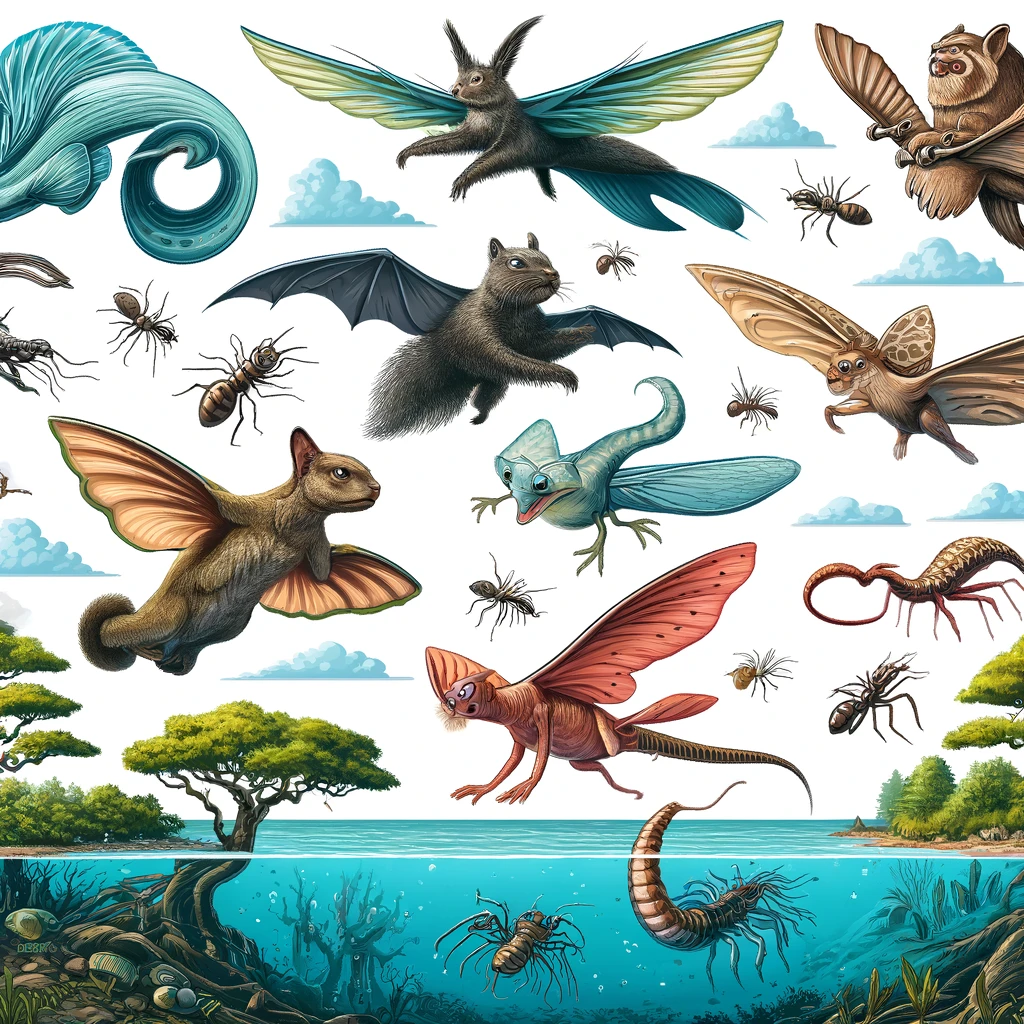Introduction
When we think of flying, birds, bats, and insects usually come to mind. But did you know there are animals that can fly without wings? These unique creatures have evolved incredible adaptations that allow them to glide through the air with ease. Let’s dive into the fascinating world of wingless flight and discover eight animals that have mastered this extraordinary skill.
What Defines Flight?
Flight without wings is more accurately described as gliding. These animals use various parts of their bodies to create lift and control their descent, allowing them to move gracefully through the air.
Flying Fish
How They Glide
Flying fish are famous for their spectacular gliding abilities. By building up speed underwater and launching themselves into the air, they can cover distances of up to 200 meters.
Unique Features
Their pectoral fins act like wings, helping them to stay airborne. They also have streamlined bodies that reduce air resistance.
Where They Are Found
These fascinating fish are commonly found in the warm, tropical oceans of the world, especially around coral reefs.
Flying Squirrel
Membrane Structure
Flying squirrels have a special membrane called the patagium that stretches from their wrists to their ankles. This acts like a parachute, allowing them to glide from tree to tree.
Gliding Mechanism
By spreading their limbs, they can steer and control their flight path, making them agile and efficient gliders.
Habitats
Flying squirrels are mostly found in forests across North America, Europe, and Asia.
Draco Lizard
Wing-like Ribs
The Draco lizard, or flying dragon, has elongated ribs that extend outwards, covered by folds of skin, creating wing-like structures.
Flight Technique
These lizards leap from trees and spread their ribs to glide, often covering distances of up to 10 meters.
Natural Habitat
Draco lizards are native to the forests of Southeast Asia, where they blend seamlessly into their leafy surroundings.
Flying Frog
Webbed Feet
Flying frogs have extensively webbed feet, which they use to glide between trees.
Gliding Process
They leap from heights, spreading their limbs wide to create lift, allowing them to travel impressive distances through the air.
Locations Found
These frogs are typically found in the rainforests of Southeast Asia.
Gliding Ant
Species Known for Gliding
Some ant species, like the Cephalotes genus, are known for their gliding abilities.
Adaptations
These ants have flattened bodies and limbs adapted for controlling their fall, allowing them to navigate back to their home tree when dislodged.
Survival Mechanisms
Gliding helps them avoid predators and find food more efficiently in the dense canopies of the Amazon rainforest.
Flying Snake
Body Movements
Flying snakes flatten their bodies and make wave-like movements to glide through the air.
Flight Mechanics
They launch themselves from trees, using their undulating motion to stay aloft and steer.
Habitats
These snakes are found in the jungles of South and Southeast Asia.
Flying Lemur (Colugo)
Membrane Details
The colugo, also known as the flying lemur, has a large membrane called the patagium that extends from its neck to the tips of its fingers, toes, and tail.
Flight Patterns
They can glide over 100 meters with ease, navigating through the forest canopy with precision.
Ecosystem
Colugos are primarily found in the tropical forests of Southeast Asia.
Flying Squid
Jet Propulsion
Flying squids use a form of jet propulsion, expelling water at high speeds to launch themselves out of the water and into the air.
Flight Capabilities
Once airborne, they spread their fins and tentacles to glide for several meters.
Regions Found
These squids are usually found in the North Pacific Ocean.
Conclusion
The world of wingless flight is full of wonders. These animals have developed incredible adaptations that allow them to glide gracefully through the air, showcasing the marvels of evolution and the diversity of life on Earth. Their unique abilities not only aid in survival but also inspire awe and curiosity about the natural world.
FAQs
1. What unique features do flying fish have?
Flying fish have enlarged pectoral fins that they use like wings to glide above the water’s surface.
2. How do flying squirrels control their glide?
Flying squirrels spread their limbs to extend the patagium, which acts like a parachute, allowing them to steer and control their flight.
3. Why do Draco lizards glide?
Draco lizards glide to escape predators, find food, and navigate the forest canopy efficiently.
4. Where are flying lemurs found?
Flying lemurs, or colugos, are found in the tropical forests of Southeast Asia.
5. How do flying squids launch themselves out of the water?
Flying squids use jet propulsion, expelling water rapidly to propel themselves into the air, where they spread their fins and tentacles to glide.

Leave a Reply